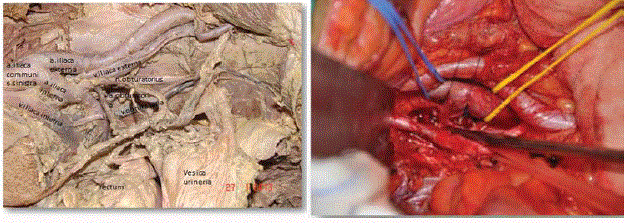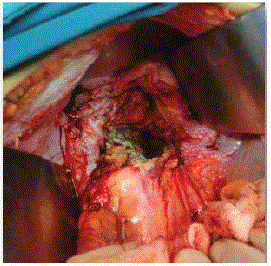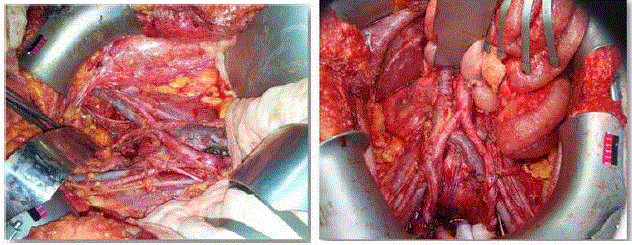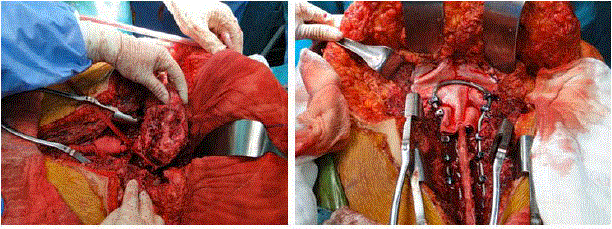Editorial
Radical Pelvic Surgery: An Orphan Child is Growıng
Selman Sokmen*
Department of Surgery, Colorectal and Pelvic Surgery, Dokuz Eylul University Medical Faculty, Izmir, Turkey
*Corresponding author: Selman Sokmen, Department of Surgery, Colorectal and Pelvic Surgery, Dokuz Eylul University Medical Faculty, Izmir, Turkey
Published: 18 Sep, 2017
Cite this article as: Sokmen S. Radical Pelvic Surgery: An
Orphan Child is Growıng. Clin Surg.
2017; 2: 1613.
Editorial
Despite significant improvements in early detection and multimodal practices, many patients still present with primary locally advanced or recurrent pelvic malignancy only amenable to some of the most challenging operations performed upon the human body. Until very recent years radical oncologic multidisciplinary pelvic surgery has not been widely performed, or at least not commonly published, techniques other than within a few internationally well-known centers. The reasons for this are obscure and manyfold: first, a surgeon who would perform any kind of multi-compartmental resective pelvic surgery with successful oncologic outcomes must first a good anatomist. However, the traditional surgical education does not include any live demonstrations of pelvic surgical techniques as well as fresh cadaveric courses (Figure 1) [1]. Neophyte surgeons can only have the chance to learn the basic tenets and advanced procedures from badly copied and cloned drawings or from the performance of his/her mentor at the institution, if there is anyone who actually likes to operate on a difficult patient with locally advanced disease in the primary and reoperative setting [2]. Lacking the required anatomical road-mapping and expertise the surgeon inevitably will make complications which are potentially daunting tasks to manage intraoperatively because of mostly irradiated, traumatized, and inflammated(reoperated) pelvic tissues(“Hostile or Difficult Pelvis”) (Figure 2) [3]. Backward analysis of imprints of a variety of unwanted complications and locoregional recurrences end up with an address of technically insufficient and improper operation. Difficulty rooted from hostility raises from the limitness of well-educated and experienced pelvic mentors, distorted anatomical planes secondary to previous incomplete trial dissections, irradiation, infective complications in the initial surgery, the technical stamina in performing en block ‘out-line’ radical pelvic resection, the lack of local fresh tissue and/or artificial organ to use in the repair and reconstruction phase which is a very crucial phase of the extensive pelvic surgery. Large advanced tumors (Figure 3), severe radioenteritis, tumoral compartmental transgression, low rectal stumph, medically unstabile patient, and inexperienced surgeon are the other well-described risk factors, particularly in the re-operative pelvic surgery [4-6]. Second, pelvic surgery naturally crosses the boundaries of several oncologic specialties. Organizing many teams to attend to the complex and prolonged operation results in considerable crowding and, undoubtedly, a cumbersome scheduling problem for the various surgeons, apparently, it does not diminish the total operative time. Most surgeons accept pelvic exenterative surgery as an operative tour de force. Good patient selection is utmost important. Carefully and adequatelly removal of all the pelvic organs or its modifications and subsequent reconstruction requires a courageous patient, a thoughtful and skillfull surgeon with advanced oncologic training and good surgical judgement, and an excellent cancer center with proven-interest in the field [7,8]. Thus, there is a need to a personalized, experienced and well-organized multidisciplinary team management for every special patient to obtain best chance of cure. But in the current era of pay-for-performance and gradually decreasing reimbursement policies of govermental support, it is again very difficult to protect a solid multidisciplinary team altogether and to attract their interests and efforts for various parts of these demanding operations. Third, there are distinct and rare types of tumors located in the pelvis with embryologically different origins and diverse biological features [9]. Most of them grow slowly in a functionally ‘silent’ area, permitting them to achieve sizable proportions without producing obvious symptoms, particularly in early stages. Locally aggressive tumors can easily infiltrate the surrounding organs and/or structures in close proximity through permissive planes and then, by transcompartmantel transgression, can produce unyielding symptoms which are not treatable/palliatable effectively with any other form of therapy than surgery for the unfortunate patients [10-13]. In addition, the biological nature of pelvic tumors cannot always be accurately predicted by clinical or pathological characteristics. For staging and therapeutic purposes, the accomplishment of the genitourinary neoplasias require aortacaval- iliac extensive lymphadenectomy (Figure 4) [14]>, that is again another adamantous surgical issue which is not taught properly in the oncologic surgery-training programs. Understanding the nature of these neoplasms is paramount to the logical performance of these marathon operative techniques. For these variety of reasons and obstacles in throughout the years, the pelvic cancer surgery has been accepted as an undiscovered oncologic field and described as an orphan child. However, in current years, the surgical oncologic habitat is changing to establish more focused oncologic attention to the pecularities and perplexing problems of diagnosing and treating of pelvic tumors at the developed specific pelvic oncology centers [15,16]. There is a long and painful, but rewarding way to go to raise the ‘orphan child’ in the near future to make a clear selection, to perform complete tumor-free resection, and to be able to reconstruct the pelvic organs/tissues with the new innovative tools in the surgical armamentarium for the sake of quality of life issues to improve the outcomes of the patients. Increased anatomic delineation capabilities of MRI and PET-CT, understanding the crucial role of total mesorectal/mesometrial resection in oncopelvic surgery, the useage of laparoscopic, endoluminal, and robotic surgery instruments in the surgeon’s toolbox, learning how to do posterior approach and sacrectomies safely and reasonably in time (Figure 5), uncovering the mysteries of the complex planner structures of pelvic sidewall, and situational awareness of educational courses, cadaveric workshops and robust publications are all expanded the constraints of pelvic oncology culture [17].
Figure 1
Figure 2
Figure 3
Figure 4
Figure 5
References
- Baggish MS. Pelvic anatomy and the surgeon. Int Urogynecol J Pelvic Floor Dysfunct. 2003;14(4):221-2.
- Valaitis SR, Rogers RG. Lifelong learning and the reconstructive pelvic surgeon. Int Urogynecol J Pelvic Floor Dysfunct. 2007;18(2):129-31.
- Edington HD, Sugarbaker PH, McDonald HD. Management of the surgically traumatized, irradiated, and infected pelvis. Surgery. 1988;103(6):690-7.
- Lopez MJ. Pelvic Cancer Surgery. Semin Surg Oncol. 1999;17:145-212.
- Lopez MJ, Barrios L. Evolution of pelvic exenteration. Surg Oncol Clin N Am. 2005;14(3):587-606, vii.
- Wanebo HJ, Begossi G, Varker KA. Surgical Management of Pelvic Malignancy: Role of Extended Abdominoperineal Resection/Exenteration/Abdominal Sacral Resection. Surg Oncol Clin N Am. 2005;14(2):197-224.
- Rodriguez-Bigas MA, Chang GJ, Skibber JM. Multidisciplinary approach to recurrent/unresectable rectal cancer: how to prepare for the extent of resection. Surg Oncol Clin N Am. 2010;19(4):847-59.
- Weese JL. Knowing when not to operate on cancer: the essence of surgical oncology and the challenge for the mentor. Ann Surg Oncol. 2006;13(4):450-2.
- Spratt JS, Meyer JS. Biological considerations with pelvic neoplasms. J Surg Oncol. 1999;71(3):198-205.
- Höckel M. Ultra-radical compartmentalized surgery in gynaecological oncology. Eur J Surg Oncol. 2006;32(8):859-65.
- Lambrou NC, Pearson JM, Averette HE. Pelvic exenteration of gynecologic malignancy: indications, and technical and reconstructive considerations. Surg Oncol Clin N Am. 2005;14(2):289-300.
- Paley P, Shah C. Pelvic Exenteration for Recurrent Pelvic Cancer. In: Billingham RP, Kobashi KC, Peters III WA (Eds): Reoperative Pelvic Surgery. Heidelberg: Springer, 2009;49-60.
- Stanhope RC. Pelvic Exenteration. In: Webb MJ, Cliby WA, Gostout BS (Eds): Manual of Pelvic Surgery (2nd Edn). Philadelphia: Lippincott Williams & Wilkins, 2000;129-34.
- Wright JD, Herzog TJ. Cytoreductive surgery: abdominal retroperitoneum and adenopathy. In: Bristow RE, Karlan BY (Eds): Surgery for Ovarian Cancer. Principles and practice. London: Taylor & Francis, 2006;171-94.
- Steele SR, Maykel JA, Champagne BJ, Orangio GR (Eds): Complexities in Colorectal Surgery. New York: Springer, 2014;63-89.
- Bristow RE, Lagasse LD. Cytoreductive surgery: pelvis. In: Bristow RE, Karlan BY (Eds): Surgery for Ovarian cancer. Principles and practice. London: Taylor & Francis, 2006;127-69.
- Patel RHH, Mould T, Joseph JV, Delaney PC. Pelvic Cancer Surgery. Modern Breakthroughs and Future Advances. London: Springer, 2015;3-49.





